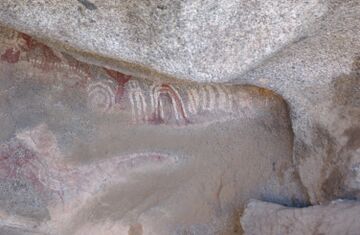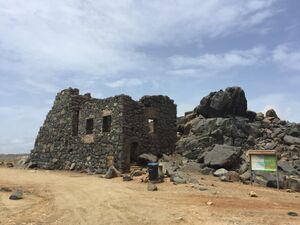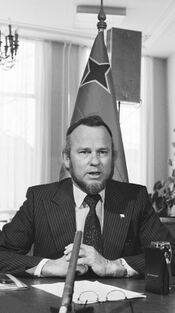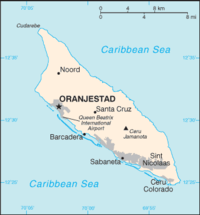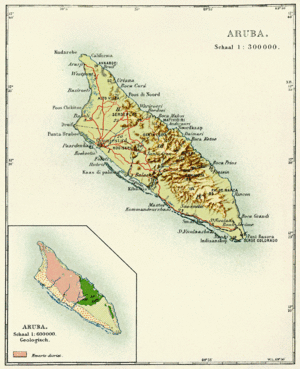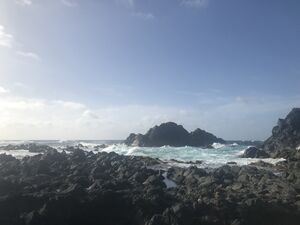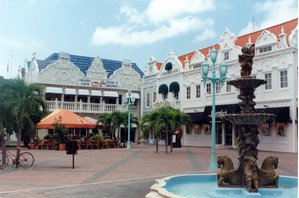آروبا
آروبا | |
|---|---|
| Anthem: "آروبا دوشي تـِرا" (العربية: "آروبا، الأرض الحلوة") | |
 موقع آروبا (في دائرة حمراء) | |
| دولة ذات سيادة | مملكة هولندا |
| قبل الانفصال | الأنتيل الهولندية |
| وضع البلد | 1 يناير 1986 |
| العاصمة | أورانجستاد 12°31′07″N 70°02′09″W / 12.51861°N 70.03583°W |
| أكبر مدينة | العاصمة |
| اللغات الرسمية | |
| الجماعات العرقية (2010) | 66% آروبيون 9.1% كولومبيون 4.3% هولنديون 4.1% دومنيكان 3.2% ڤنزويليون 2.2% Curaçaoan 1.5% Haitian 1.2% Surinamese 1.1% Peruvian 1.1% Chinese 6.2% other[2] |
| صفة المواطن | آروبي |
| الحكومة | Parliamentary representative democracy within a constitutional monarchy |
• Monarch | Willem-Alexander |
• الحاكم | Alfonso Boekhoudt |
| Evelyn Wever-Croes | |
| Legislature | Estates of Aruba |
| المساحة | |
• Total | 180[3] km2 (69 sq mi) |
• Water (%) | negligible |
| أعلى منسوب | 188 m (617 ft) |
| التعداد | |
• 1 January 2019 estimate | 116,576[3] (193rd) |
• Density | 624/km2 (1،616.2/sq mi) (22nd) |
| GDP (PPP) | 2019 estimate |
• Total | $4.4 billion |
• Per capita | $37,576[4] |
| GDP (nominal) | 2019 estimate |
• Total | $3.4 billion |
• Per capita | $28,898[4] |
| HDI (2013) | 0.908 very high |
| العملة | Aruban florin (AWG) |
| Time zone | UTC-4:00 (AST) |
| Mains electricity | 127 V–60 Hz |
| Driving side | right |
| Calling code | +297 |
| ISO 3166 code | |
| Internet TLD | .aw |
Aruba (/əˈruːbə/ ə-ROO-bə, هولندية: [aːˈrubaː, -ryb-] (![]() استمع), پاپيامنتو: [aˈruba]) is an island and a constituent country of the Kingdom of the Netherlands in the mid-south of the Caribbean Sea, about 29 كيلومتر (18 mi) north of the Venezuelan peninsula of Paraguaná and 80 كيلومتر (50 mi) northwest of Curaçao.[5] It measures 32 كيلومتر (20 mi) long from its northwestern to its southeastern end and 10 كيلومتر (6 mi) across at its widest point.[5] Together with Bonaire and Curaçao, Aruba forms a group referred to as the ABC islands. Collectively, these and the other three Dutch substantial islands in the Caribbean are often called the Dutch Caribbean, of which Aruba has about one-third of the population.
استمع), پاپيامنتو: [aˈruba]) is an island and a constituent country of the Kingdom of the Netherlands in the mid-south of the Caribbean Sea, about 29 كيلومتر (18 mi) north of the Venezuelan peninsula of Paraguaná and 80 كيلومتر (50 mi) northwest of Curaçao.[5] It measures 32 كيلومتر (20 mi) long from its northwestern to its southeastern end and 10 كيلومتر (6 mi) across at its widest point.[5] Together with Bonaire and Curaçao, Aruba forms a group referred to as the ABC islands. Collectively, these and the other three Dutch substantial islands in the Caribbean are often called the Dutch Caribbean, of which Aruba has about one-third of the population.
Aruba is one of the four countries that form the Kingdom of the Netherlands, along with the Netherlands, Curaçao, and Sint Maarten; the citizens of these countries are all Dutch nationals.[6] Aruba has no administrative subdivisions, but, for census purposes, is divided into eight regions. Its capital is Oranjestad.[6][5]
Unlike much of the Caribbean region, Aruba has a dry climate and an arid or desert, cactus-strewn landscape.[5][6] This climate has helped tourism as visitors to the island can reliably expect warm, sunny clear skies year-round. Its land covers 179 km2 (69.1 sq mi) and is quite densely populated, by 101,484 inhabitants, as at the 2010 Census. Current estimates of the population place it at 116,600 (July 2018 est.)[6] It is south of the typical latitudes of hurricanes[6] but was affected by two in their early stages in late 2020.
أصل الاسم
There are different theories as to the origin of the name Aruba:[6][7]
- From the Spanish Oro hubo which means "there was gold"[6]
- From the Island Carib word Oruba which means "well-placed"[6]
- From the Island Carib words Ora ("shell") and Oubao ("island")[8]
تاريخ
Pre-colonial era
There has been a human presence on Aruba from as early as circa 2000 BC.[9] The first identifiable group are the Arawak Caquetío Amerindians who migrated from South America about 1000 AD.[9][10] Archaeological evidence suggests continuing links between these native Arubans and Amerindian peoples of mainland South America.[7]
Spanish Colonization
The first Europeans to visit Aruba were Amerigo Vespucci and Alonso de Ojeda in 1499, who claimed the island for Spain.[9] Both men described Aruba as an "island of giants", remarking on the comparatively large stature of the native Caquetíos.[7] Vespucci returned to Spain with stocks of cotton and brazilwood from the island and described houses built into the ocean.[بحاجة لمصدر] Vespucci and Ojeda's tales spurred interest in Aruba, and the Spanish began colonising the island.[11][12] Alonso de Ojeda was appointed the island's first governor in 1508. From 1513 the Spanish began enslaving the Caquetíos, sending many to a life of forced labour in the mines of Hispaniola.[7][9] The island's low rainfall and arid landscape meant that it was not considered profitable for a slave-based plantation system, so the type of large-scale slavery so common on other Caribbean islands never became established on Aruba.[13]
Early Dutch period
The Netherlands seized Aruba from Spain in 1636 in the course of the Thirty Years' War.[5][9] Peter Stuyvesant, later appointed to New Amsterdam (New York), was the first Dutch governor. Those Arawak who had survived the depredations of the Spanish were allowed to farm and graze livestock, with the Dutch using the island as a source of meat for their other possessions in the Caribbean.[7][9] Aruba's proximity to South America resulted in interactions with the cultures of the coastal areas; for example, architectural similarities can be seen between the 19th-century parts of Oranjestad and the nearby Venezuelan city of Coro in Falcón State.[بحاجة لمصدر] Historically, Dutch was not widely spoken on the island outside of colonial administration; its use increased in the late 19th and early 20th centuries.[14] Students on Curaçao, Aruba, and Bonaire were taught predominantly in Spanish until the late 18th century.[15]
During the Napoleonic Wars the British Empire took control of the island, occupying it between 1806 and 1816, before handing it back to the Dutch as per the terms of the Anglo-Dutch Treaty of 1814.[7][5][16][9] Aruba subsequently became part of the Colony of Curaçao and Dependencies along with Bonaire. During the 19th century an economy based on gold mining, phosphate production and aloe vera plantations developed, however the island remained a relatively poor backwater.[7]
20th and 21st centuries
The first oil refinery in Aruba was built in 1928 by Royal Dutch Shell. The facility was built just to the west of the capital city Oranjestad and was commonly called the Eagle. Immediately following this, another refinery was built by Lago Oil and Transport Company in an area now known as San Nicolas on the east end of Aruba. These refineries processed crude oil from the vast Venezuelan oil fields, bringing greater prosperity to the island.[17] The refinery on Aruba grew to become one of the largest in the world.[7]
During World War II, the Netherlands was occupied by Nazi Germany. In 1940, the oil facilities in Aruba came under the administration of the Dutch government-in-exile in London, causing them to be attacked by the German navy in 1942.[7][18]
In August 1947, Aruba presented its first Staatsreglement (constitution) for Aruba's status aparte as an autonomous state within the Kingdom of the Netherlands, prompted by the efforts of Henny Eman, a noted Aruban politician. By 1954, the Charter of the Kingdom of the Netherlands was established, providing a framework for relations between Aruba and the rest of the Kingdom.[19] This created the Netherlands Antilles, which united all of the Dutch colonies in the Caribbean into one administrative structure.[20] Many Arubans were unhappy at the arrangement, however, as the new polity was perceived as being dominated by Curaçao.[5]
In 1972, at a conference in Suriname, Betico Croes, a politician from Aruba, proposed the creation of a Dutch Commonwealth of four states: Aruba, the Netherlands, Suriname, and the Netherlands Antilles, each to have its own nationality. Backed by his newly created party (the Movimiento Electoral di Pueblo), Croes sought greater autonomy for Aruba, with the long-term goal of independence, adopting the trappings of an independent state in 1976 with the creation of a flag and national anthem.[7] In March 1977, a referendum was held with the support of the United Nations; 82% of the participants voted for complete independence from the Netherlands.[7][21] Tensions mounted as Croes stepped up the pressure on the Dutch government by organising a general strike in 1977.[7] Croes later met with Dutch Prime Minister Joop den Uyl, with the two sides agreeing to assign the Institute of Social Studies in The Hague to prepare a study for independence, entitled Aruba en Onafhankelijkheid, achtergronden, modaliteiten, en mogelijkheden; een rapport in eerste aanleg (Aruba and independence, backgrounds, modalities, and opportunities; a preliminary report) (1978).[7]
الاستقلال الذاتي
In March 1983, Aruba reached an official agreement within the Kingdom for its independence, to be developed in a series of steps as the Crown granted increasing autonomy. In August 1985, Aruba drafted a constitution that was unanimously approved. On 1 January 1986, after elections were held for its first parliament, Aruba seceded from the Netherlands Antilles, officially becoming a country of the Kingdom of the Netherlands, with full independence planned for 1996.[7] However, Croes was seriously injured in a traffic accident in 1985, slipping into a coma; he died in 1986, never seeing the enaction of status aparte for Aruba for which he had worked over many years.[7] After his death in 1986, Croes was proclaimed Libertador di Aruba.[7] Thus Henny Eman of the Aruban People's Party (AVP) became the first Prime Minister of Aruba. Meanwhile, Aruba's oil refinery shut, negatively impacting the economy. As a result, Aruba pushed for a dramatic increase in tourism, with this sector growing to become the island's largest industry.[7]
At a convention in The Hague in 1990, at the request of Aruba's Prime Minister Nelson Oduber, the governments of Aruba, the Netherlands, and the Netherlands Antilles postponed indefinitely Aruba's transition to full independence.[7] The article scheduling Aruba's complete independence was rescinded in 1995, although the process could be revived after another referendum.
الجغرافيا
Aruba is a generally flat, riverless island in the Leeward Antilles island arc of the Lesser Antilles in the southern part of the Caribbean. It lies 77 km (48 mi) west of Curaçao and 29 km (18 mi) north of Venezuela's Paraguaná Peninsula.[5] Aruba has white sandy beaches on the western and southern coasts of the island, relatively sheltered from fierce ocean currents.[5][22] This is where the bulk of the population live and where most tourist development has occurred.[22][6] The northern and eastern coasts, lacking this protection, are considerably more battered by the sea and have been left largely untouched.
The hinterland of the island features some rolling hills, such as Hooiberg at 165 متر (541 ft) and Mount Jamanota, the highest on the island at 188 متر (617 ft) above sea level.[5][6] Oranjestad, the capital, is located at 12°31′01″N 70°02′04″W / 12.51694°N 70.03444°W.
The Natural Bridge was a large, naturally formed limestone bridge on the island's north shore. It was a popular tourist destination until its collapse in 2005.
Cities and towns
The island, with a population of about 116,600 people (July 2018 est.)[6] does not have major cities. It is divided into six districts.[23] Most of the island's population resides in or around the two major city-like districts of Oranjestad (the capital) and San Nicolaas. Oranjestad and San Nicolaas are both divided into two districts for census purposes only.[24] The districts are as follows:
- Noord
- Oranjestad (East and West)
- Paradera
- San Nicolaas (North and South)
- Santa Cruz
- Savaneta
Fauna
The isolation of Aruba from the mainland of South America has fostered the evolution of multiple endemic animals. The island provides a habitat for the endemic Aruban Whiptail and Aruba Rattlesnake, as well as an endemic subspecies of Burrowing Owl and Brown-throated Parakeet.
Flora
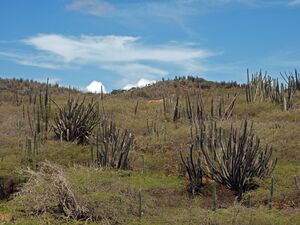
The flora of Aruba differs from the typical tropical island vegetation. Xeric scrublands are common, with various forms of cacti, thorny shrubs, and evergreens.[5] Aloe vera is also present, its economic importance earning it a place on the Coat of Arms of Aruba.
Cacti like Melocactus and Opuntia are represented on Aruba by species like Opuntia stricta. Trees like Caesalpinia coriaria and Vachellia tortuosa are drought tolerant.
المناخ
By the Köppen climate classification, Aruba has a hot semi-arid climate (Köppen BSh).[25] Mean monthly temperature in Oranjestad varies little from 26.7 °C (80.1 °F) to 29.2 °C (84.6 °F), moderated by constant trade winds from the Atlantic Ocean, which come from the north-east. Yearly rainfall barely exceeds 450 ميليمتر أو 18 بوصات in Oranjestad, although it is extremely variable[26] and can range from as little as 150 ميليمتر أو 6 بوصات during strong El Niño years (e.g. 1911/1912, 1930/1931, 1982/1983, 1997/1998) to over 1،000 ميليمتر أو 39 بوصات in La Niña years like 1933/1934, 1970/1971 or 1988/1989.
| بيانات المناخ لـ Oranjestad, Aruba (normals 1991–2020, extremes 1951–2020) | |||||||||||||
|---|---|---|---|---|---|---|---|---|---|---|---|---|---|
| الشهر | ينا | فب | مار | أبر | ماي | يون | يول | أغس | سبت | أكت | نوف | ديس | السنة |
| القصوى القياسية °س (°ف) | 32.5 (90.5) |
33.0 (91.4) |
33.9 (93.0) |
34.4 (93.9) |
34.9 (94.8) |
35.2 (95.4) |
35.3 (95.5) |
36.1 (97.0) |
36.5 (97.7) |
35.4 (95.7) |
35.0 (95.0) |
34.8 (94.6) |
36.5 (97.7) |
| متوسط القصوى اليومية °س (°ف) | 30.3 (86.5) |
30.6 (87.1) |
31.1 (88.0) |
31.9 (89.4) |
32.0 (89.6) |
32.5 (90.5) |
32.4 (90.3) |
33.2 (91.8) |
33.2 (91.8) |
32.4 (90.3) |
31.5 (88.7) |
30.7 (87.3) |
31.8 (89.2) |
| المتوسط اليومي °س (°ف) | 27.0 (80.6) |
27.1 (80.8) |
27.4 (81.3) |
28.2 (82.8) |
28.7 (83.7) |
29.0 (84.2) |
28.9 (84.0) |
29.5 (85.1) |
29.6 (85.3) |
29.1 (84.4) |
28.4 (83.1) |
27.5 (81.5) |
28.4 (83.1) |
| متوسط الدنيا اليومية °س (°ف) | 24.8 (76.6) |
24.8 (76.6) |
25.3 (77.5) |
26.0 (78.8) |
26.7 (80.1) |
26.9 (80.4) |
26.7 (80.1) |
27.2 (81.0) |
27.3 (81.1) |
26.7 (80.1) |
26.0 (78.8) |
25.3 (77.5) |
26.1 (79.0) |
| الصغرى القياسية °س (°ف) | 19.0 (66.2) |
20.6 (69.1) |
21.2 (70.2) |
21.5 (70.7) |
21.8 (71.2) |
22.7 (72.9) |
21.2 (70.2) |
21.3 (70.3) |
22.1 (71.8) |
21.9 (71.4) |
22.0 (71.6) |
20.5 (68.9) |
19.0 (66.2) |
| متوسط تساقط الأمطار mm (inches) | 44.0 (1.73) |
19.5 (0.77) |
10.0 (0.39) |
8.6 (0.34) |
14.1 (0.56) |
17.4 (0.69) |
31.4 (1.24) |
19.6 (0.77) |
42.9 (1.69) |
76.5 (3.01) |
87.1 (3.43) |
80.1 (3.15) |
451.1 (17.76) |
| Average rainy days (≥ 1.0 mm) | 10.8 | 4.5 | 2.0 | 1.5 | 1.7 | 2.8 | 4.1 | 3.1 | 3.3 | 7.3 | 9.6 | 11.0 | 61.7 |
| متوسط الرطوبة النسبية (%) | 77.8 | 76.2 | 75.9 | 76.9 | 77.9 | 77.4 | 77.8 | 75.6 | 76.2 | 77.9 | 78.8 | 77.9 | 77.2 |
| Source: Departamento Meteorologico Aruba[27][28][29][30] | |||||||||||||
الديمغرافيا
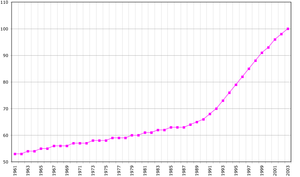
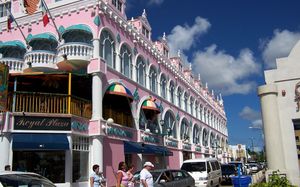
In terms of country of birth, the population is estimated to be 66% Aruban, 9.1% Colombian, 4.3% Dutch, 4.1% Dominican, 3.2% Venezuelan, 2.2% Curaçaoan, 1.5% Haitian, 1.2% Surinamese, 1.1% Peruvian, 1.1% Chinese, 6.2% other.[2]
In terms of ethnic composition, the population is estimated to be 75% mestizo, 15% black and 10% other ethnicities.[بحاجة لمصدر] Arawak heritage is stronger on Aruba than on most Caribbean islands; although no full-blooded Aboriginals remain, the features of the islanders clearly indicate their genetic Arawak heritage.[بحاجة لمصدر] Most of the population is descended from Caquetio Indians, African slaves, and Dutch settlers, and to a lesser extent the various other groups that have settled on the island over time, such as the Spanish, Portuguese, English, French, and Sephardic Jews.
Recently, there has been substantial immigration to the island from neighbouring South American and Caribbean nations, attracted by the higher paid jobs. In 2007, new immigration laws were introduced to help control the growth of the population by restricting foreign workers to a maximum of three years residency on the island.[31] Most notable are those from Venezuela, which lies just 29 km (18 mi) to the south.
Language
The official languages are Dutch and Papiamento. However, whilst Dutch is the sole language for all administration and legal matters,[32] Papiamento is the predominant language used on Aruba. It is a creole language, spoken on Aruba, Bonaire, and Curaçao, that incorporates words from Portuguese, various West African languages, Dutch, and Spanish.[5] English is also spoken, its usage having grown due to tourism.[5][6] Other common languages spoken, based on the size of their community, are Spanish, Portuguese, Cantonese, French and German.
In recent years, the government of Aruba has shown an increased interest in acknowledging the cultural and historical importance of Papiamento. Although spoken Papiamento is fairly similar among the several Papiamento-speaking islands, there is a big difference in written Papiamento.[بحاجة لمصدر] The orthography differs per island, with Aruba using etymological spelling, and Curaçao and Bonaire a phonetic spelling. Some are more oriented towards Portuguese and use the equivalent spelling (e.g. "y" instead of "j"), where others are more oriented towards Dutch.
The book Buccaneers of America, first published in 1678, states through eyewitness account that the natives on Aruba spoke Spanish already.[33] Spanish became an important language in the 18th century due to the close economic ties with Spanish colonies in what are now Venezuela and Colombia.[34] Venezuelan TV networks are received on the island, and Aruba also has significant Venezuelan and Colombian communities.[بحاجة لمصدر] Around 12.6% of the population today speaks Spanish natively.[35] Use of English dates to the early 19th century, when the British took Curaçao, Aruba, and Bonaire. When Dutch rule resumed in 1815, officials already noted wide use of the language.[14]
Aruba has newspapers published in Papiamento: Diario, Bon Dia, Solo di Pueblo, and Awe Mainta, English: Aruba Daily, Aruba Today, and The News, and Dutch: Amigoe. Aruba has 18 radio stations (two AM and 16 FM) and two television stations (Telearuba and Channel 22).[36]
Religion
Roman Catholicism is the dominant religion, practiced by about 75% of the population.[2][6] Various Protestant denominations are also present on the island.[6][5]
المناطق
Aruba is cartographically split into eight for censuses; these regions have no administrative function; some allude to parishes which include a few charitable community facilities:
| Name | Area (km2) | Population 1991 Census |
Population 2000 Census |
Population 2010 Census |
|---|---|---|---|---|
| Noord / Tanki Leendert | 34٫62 | 10٬056 | 16٬944 | 21٬495 |
| Oranjestad West | 9٫29 | 8٬779 | 12٬131 | 13٬976 |
| Oranjestad Oost | 12٫88 | 11٬266 | 14٬224 | 14٬318 |
| Paradera | 20٫49 | 6٬189 | 9٬037 | 12٬024 |
| San Nicolas Noord | 23٫19 | 8٬206 | 10٬118 | 10٬433 |
| San Nicolas Zuid | 9٫64 | 5٬304 | 5٬730 | 4٬850 |
| Santa Cruz | 41٫04 | 9٬587 | 12٬326 | 12٬870 |
| Savaneta | 27٫76 | 7٬273 | 9٬996 | 11٬518 |
| Total Aruba | 178٫91 | 66٬687 | 90٬506 | 101٬484 |
الاقتصاد
The island's economy is dominated by four main industries: tourism, aloe export, petroleum refining, and offshore banking.[6][5] Aruba has one of the highest standards of living in the Caribbean region. The GDP per capita (PPP) for Aruba was estimated to be $37,500 in 2017.[37] Its main trading partners are Colombia, the United States, Venezuela, and the Netherlands.
The agriculture and manufacturing sectors are fairly minimal. Gold mining was important in the 19th century.[5] Aloe was introduced to Aruba in 1840 but did not become a big export until 1890. Cornelius Eman founded Aruba Aloe Balm, and over time the industry became very important to the economy. At one point, two-thirds of the island was covered in Aloe Vera fields, and Aruba became the largest exporter of aloe in the world. The industry continues today, though on a smaller scale.
Access to biocapacity in Aruba is much lower than world average. In 2016, Aruba had 0.57 global hectares [38] of biocapacity per person within its territory, much less than the world average of 1.6 global hectares per person.[39] In 2016 Aruba used 6.5 global hectares of biocapacity per person - their ecological footprint of consumption. This means they use almost 12 times the biocapacity that Aruba contains. This is the extent of Aruba's biocapacity deficit.[38]
The official exchange rate of the Aruban florin is pegged to the US dollar at 1.79 florins to US$1.[5][40][41] This fact, and the majority of tourists being US, means businesses of hotel and resort districts prefer to bank and trade with the consumer in US dollars.
Aruba is a prosperous country. Unemployment is low (although the government has not published statistics since 2013) and per capita income is one of the highest in the Caribbean (approximately $24,087). At the end of 2018, the labor force participation rate was 56.6% for women.
Until the mid-1980s, Aruba's main industry was oil refining. Then the refinery was shut down and the island's economy shifted towards tourism. Currently, Aruba receives about 1,235,673 (2007) guests per year, of which three-quarters are Americans. Tourism is mainly focused on the beaches and the sea. The refinery has been closed and restarted repeatedly during the last decades. In recent years a letter of intent was signed with CITGO (the US subsidiary of the Venezuelan state oil company PDVSA) to explore the possibility of reopening the refinery again.
Until 2009, the Netherlands granted development aid to Aruba. This aid was mainly for law enforcement, education, administrative development, health care and sustainable economic development. This aid was discontinued at Aruba's request in 2009. Since 2015, however, a form of financial supervision has been reintroduced because Aruba's debt has risen sharply to over 80% of GDP.
Aruba also has two free trade zones (Barcadera and Bushiri), where import and export and the movement of services are tax-free.[42]
السياحة
About 3⁄4 of the Aruban gross national product is earned through tourism and related activities.[43] Most tourists are from North America, with a market-share of 73.3%, followed by Latin America with 15.2% and Europe with 8.3%.[44]
For private aircraft passengers bound for the United States, the United States Department of Homeland Security (DHS), U.S. Customs and Border Protection (CBP) has a full pre-clearance facility since 1 February 2001 when Queen Beatrix Airport expanded. Since 2008, Aruba has been the only island to have this service for private flights.[45]
Aruba has a large and well-developed tourism industry, receiving 1,082,000 tourists who stayed overnight in its territory in 2018. The largest number of tourists come from North America (mainly the United States), with a market share of 73.3%, in addition to 15.2% from Latin America (mainly Venezuela) and 8.3% from Europe. In 2018 there were 40,231 visitors from the Netherlands. There are many luxury and lesser luxury hotels, concentrated mainly on the west coast beaches. In Palm Beach are the luxury hotels aimed at American tourists. This area is also called "Highrise-area", because most of the hotels are located in (by Aruban standards) high-rise buildings. Eagle Beach, a short distance from Palm Beach in the direction of Oranjestad, offers hotels on a somewhat smaller and more intimate scale in low-rise buildings, hence the name "lowrise-area".
Oranjestad is, in addition to the capital, an important place in the tourist industry. Here is the port for the many cruise ships that visit Aruba. The cruise industry is a very important pillar of tourism in Aruba, since during a cruise a large part of the passengers go ashore to visit the island. With 334 "cruise calls", Aruba received 815,161 cruise tourists in 2018. According to some sources the 2017/2018 cruise season brought $102.8 million to Aruba's economy. Oranjestad is also home to several luxury hotels, upscale shopping malls, and tourist-oriented shopping streets, including "Mainstreet," and hospitality facilities. The main street, called Caya G.F. (Betico) Croes, has been redesigned in recent years, including new paving, new palm trees and a streetcar line for tourists.
Also elsewhere on the island you can find the necessary tourist accommodation, even in (private) apartment buildings.
الثقافة
أماكن مهمة
|
|
* Collapsed September 2, 2005 [46]
انظر أيضاً
- Communications in Aruba
- Divi-divi
- Foreign relations of Aruba
- Military of Aruba
- Scouting Aruba
- Transportation in Aruba
المصادر
هذه المقالة بحاجة لمصادر إضافية لتحسين وثوقيتها. (May 2007) |
- ^ Migge, Bettina; Léglise, Isabelle; Bartens, Angela (2010). Creoles in Education: An Appraisal of Current Programs and Projects. Amsterdam: John Benjamins Publishing Company. p. 268. ISBN 978-90-272-5258-6. Archived from the original on 3 May 2016. Retrieved 7 May 2016.
- ^ أ ب ت ث ج "The World Factbook – Central Intelligence Agency". cia.gov. Retrieved 25 August 2017.
- ^ أ ب "Waaruit bestaat het Koninkrijk der Nederlanden? - Rijksoverheid.nl". onderwerpen (in الهولندية). Ministerie van Algemene. 19 May 2015.
- ^ أ ب "Report for Selected Countries and Subjects". www.imf.org.
- ^ أ ب ت ث ج ح خ د ذ ر ز س ش ص ض ط ظ "Aruba". Encyclopædia Britannica. Archived from the original on 15 May 2015. Retrieved 28 July 2019.
- ^ أ ب ت ث ج ح خ د ذ ر ز س ش ص ض "CIA World Factbook - Aruba". Retrieved 28 July 2019.
- ^ أ ب ت ث ج ح خ د ذ ر ز س ش ص ض ط ظ ع "Historia di Aruba". Archived from the original on 9 April 2013. Retrieved 28 July 2019.
- ^ Brushaber, Susan; Greenberg, Arnold (2001). Aruba, Bonaire & Curacao Alive!. Hunter Publishing, Inc. p. 38. ISBN 978-1-58843-259-9.
- ^ أ ب ت ث ج ح خ "Aruba History". Archived from the original on 28 July 2019. Retrieved 28 July 2019.
- ^ "Rock Formations". Aruba.com. Archived from the original on 10 January 2011. Retrieved 1 January 2011.
- ^ Sullivan, Lynne M. (2006). Adventure Guide to Aruba, Bonaire & Curaçao. Edison, NJ: Hunter Publishing, Inc. pp. 57–58. ISBN 9781588435729. Archived from the original on 14 May 2016. Retrieved 23 October 2015.
- ^ Sauer, Carl Ortwin (1966). The Early Spanish Main. Cambridge: Cambridge University Press. p. 112. ISBN 9780521088480. Archived from the original on 3 May 2016. Retrieved 23 October 2015.
- ^ "Sitios de Memoria de la Ruta del Esclavo en el Caribe Latino". www.lacult.unesco.org. Archived from the original on 31 March 2019. Retrieved 2019-03-04.
- ^ أ ب Dede pikiña ku su bisiña: Papiamentu-Nederlands en de onverwerkt verleden tijd. van Putte, Florimon., 1999. Zutphen: de Walburg Pers
- ^ Van Putte 1999.
- ^ "British Empire: Caribbean: Aruba". Archived from the original on 9 April 2013. Retrieved 14 June 2015.
- ^ Albert Gastmann, "Suriname and the Dutch in the Caribbean" in Encyclopedia of Latin American History and Culture, vol. 5, p. 189. New York: Charles Scribner's Sons 1996.
- ^ Central American and Caribbean Air Forces, Daniel Hagedorn, Air Britain (Historians) Ltd., Tonbridge, 1993, p.135, ISBN 0 85130 210 6
- ^ Robbers, Gerhard (2007). Encyclopedia of World Constitutions. Vol. 1. New York City: Facts on File, Inc. p. 649. ISBN 978-0-8160-6078-8. Archived from the original on 23 April 2016. Retrieved 23 October 2015.
- ^ "Status change means Dutch Antilles no longer exists". BBC News. BBC. 10 October 2010. Archived from the original on 11 October 2010. Retrieved 11 October 2010.
- ^ "BBC News — Aruba profile — Timeline". BBC. 5 November 2013. Archived from the original on 30 August 2014. Retrieved 15 July 2014.
- ^ أ ب Canoe inc. (22 June 2011). "Aruba: the happy island". Slam.canoe.ca. Archived from the original on 13 April 2014. Retrieved 15 July 2014.
- ^ "Cities in Aruba - Guide to Aruba's Biggest Cities" (in الإنجليزية الأمريكية). Archived from the original on 23 December 2018. Retrieved 2018-06-03.
- ^ Aruba Central Bureau of Statistics (29 September 2010). Fifth Population and Housing Census, 2010: Selected Tables. pp. 75–76. Archived from the original. You must specify the date the archive was made using the
|archivedate=parameter. http://cbs.aw/wp/wp-content/uploads/2012/07/Fifth-Population-and-Housing-Census-Aruba.pdf. Retrieved on 3 June 2018. - ^ "Climate Data Aruba". Departamento Meteorologico Aruba. Archived from the original on 14 October 2012. Retrieved 15 October 2012.
- ^ Dewar, Robert E. and Wallis, James R; 'Geographical patterning in interannual rainfall variability in the tropics and near tropics: An L-moments approach'; in Journal of Climate, 12; pp. 3457–3466
- ^ "Summary Climatological Normals Period 1991–2020" (PDF). Departamento Meteorologico Aruba. Archived (PDF) from the original on 15 February 2021. Retrieved 14 February 2021.
- ^ "Summary Climatological Normals Period 1951–1980" (PDF). Departamento Meteorologico Aruba. Retrieved 14 February 2021.
{{cite web}}: CS1 maint: url-status (link) - ^ "Summary Climatological Normals Period 1971–2000" (PDF). Departamento Meteorologico Aruba. Retrieved 14 February 2021.
{{cite web}}: CS1 maint: url-status (link) - ^ "Summary Climatological Normals Period 1981–2010" (PDF). Departamento Meteorologico Aruba. Retrieved 14 February 2021.
{{cite web}}: CS1 maint: url-status (link) - ^ "A Situational Analysis of Aruba's Response to Human Trafficking" (PDF). International Organization for Migration.
{{cite web}}: CS1 maint: url-status (link) - ^ "About Us". DutchCaribbeanLegalPortal.com. Archived from the original on 20 June 2014. Retrieved 20 May 2014.
- ^ "History of Aruba in Timeline - Popular Timelines". populartimelines.com (in الإنجليزية). Retrieved 2020-05-29.
- ^ Dede pikiña ku su bisiña: Papiamentu-Nederlands en de onverwerkt verleden tijd. van Putte, Florimon., 1999. Zutphen: de Walburg Pers
- ^ Central Intelligence Agency (2009). "Aruba". The World Factbook. Retrieved 6 June 2011.
- ^ "Aruba - arubanoasis". www.arubanoasis.com. Retrieved 2020-05-29.
- ^ CIA (10 September 2019). "Aruba". CIA World Factbook. Retrieved 12 September 2019.
- ^ أ ب "Country Trends". Global Footprint Network. Retrieved 4 June 2020.
- ^ Lin, David; Hanscom, Laurel; Murthy, Adeline; Galli, Alessandro; Evans, Mikel; Neill, Evan; Mancini, MariaSerena; Martindill, Jon; Medouar, FatimeZahra; Huang, Shiyu; Wackernagel, Mathis (2018). "Ecological Footprint Accounting for Countries: Updates and Results of the National Footprint Accounts, 2012-2018". Resources (in الإنجليزية). 7 (3): 58. doi:10.3390/resources7030058.
- ^ "Convert Dollars to Aruba Florin | USD to AWG Currency Converter". Currency.me.uk. Archived from the original on 3 July 2014. Retrieved 15 July 2014.
- ^ "Convert United States Dollar to Aruban Florin | USD to AWG Currency Converter". Themoneyconverter.com. Archived from the original on 31 July 2014. Retrieved 15 July 2014.
- ^ "Barcadera Free Zone". Free Zone Aruba. Retrieved 1 May 2021.
- ^ "The World Factbook – Central Intelligence Agency". Cia.gov. Retrieved 12 October 2016.
- ^ "Toerisme Aruba naar recordhoogte" (in الهولندية). Antilliaans Dagblad. 5 May 2019. Archived from the original on 6 May 2019. Retrieved 24 May 2019.
- ^ "Aruba". HighEnd-traveller.com (in الإنجليزية الأمريكية). 31 May 2016. Archived from the original on 8 December 2017. Retrieved 2017-12-08.
- ^ Coral bridge, natural Aruba tourist spot, collapses
وصلات خارجية
- آروبا travel guide from Wikitravel
- Central Bank of Aruba
- Aruba Ports Authority
- Aruba Airport Authority
- Aruba Health Insurance (AZV)
- Aruba.com - Governmental Tourism Portal
- University of Aruba
- Aruba entry at The World Factbook
- Aruba Paper Money
- NosFM.com - Radio stations in Aruba's language; Papiamento
- CS1 الهولندية-language sources (nl)
- CS1 الإنجليزية الأمريكية-language sources (en-us)
- CS1 maint: url-status
- Short description is different from Wikidata
- Articles containing explicitly cited عربية-language text
- Pages using gadget WikiMiniAtlas
- Pages using infobox political division with unknown parameters
- Articles with hatnote templates targeting a nonexistent page
- Articles with unsourced statements from July 2019
- Articles needing additional references from May 2007
- All articles needing additional references
- مقالات ناطقة
- آروبا
- بلدان جزر
- 10th-century establishments in Aruba
- 1499 establishments in the Spanish Empire
- 1636 disestablishments in the Spanish Empire
- 1636 establishments in the Dutch Empire
- 1799 disestablishments in the Dutch Empire
- 1799 establishments in the British Empire
- 1802 disestablishments in the British Empire
- 1802 establishments in the Dutch Empire
- 1804 disestablishments in the Dutch Empire
- 1804 establishments in the British Empire
- 1816 disestablishments in the British Empire
- 1816 establishments in the Dutch Empire
- 1986 disestablishments in the Netherlands Antilles
- 1986 establishments in Aruba
- بلدان كاريبية في مملكة هولندا
- بلدان وأقاليم ناطقة بالهولندية
- Former Dutch colonies
- Former Spanish colonies
- Former British colonies
- Islands of the Netherlands Antilles
- Populated places established in the 10th century
- Small Island Developing States
- Special territories of the European Union
- دول وأقاليم تأسست في 1986
- Dependent territories in the Caribbean
- جزر الكاريبي
- هولندا
- Aruba
- جزر الأنتيل الصغرى
- أراضي خاصة في الاتحاد الاوروپي
- Dutch-speaking countries


